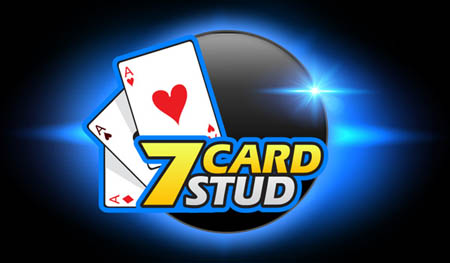
FOR THE WIN DOWNLOAD NOW
Seven Card Stud ruled the roost before Omaha and Hold’em were popularized. Widely considered by many to be the purest poker variant of them all, Seven Card Stud has a rich and decorated history with poker players. For starters, players will be required to pay close attention in this game much like they do in games of Gin or Bridge. Once you have mastered the art of Seven Card Stud, you will be positioned to take down many more monster pots in this community-style card game. Get comfortable with 888poker as we take you on a whirlwind tour with the fascinating game of Seven Card Stud.
Mastery of Seven Card Stud takes tremendous time and effort. This game requires each player to be dealt 7 cards during the hand. But here’s the clincher: only the best 5-card hand is used to determine the winner of Seven Card Stud Poker games. This game differs from other popular variants in Omaha Hi-Lo and Texas Hold’em Poker in that it is played with a limit structure. The bets are fixed – say $4/$8, and they increase in set increments during the first 2 betting rounds at the lower limit of $4, and in increments of $8 during the next 3 rounds of betting. Now that you know a little bit more about Seven Card Stud, let’s give you a little history and some fascinating insights into this great poker game!
Seven Card Stud – The History
Seven Card Stud is arguably the world’s oldest poker game. While it’s simple to learn, it is difficult to master. Let’s rewind a little, and find out how this game became a power player in the poker arena. To be fair, the precise origin of Seven Card Stud is shrouded in mystery. Some folks believe that it stems from a French game named Poque, from the German word Pochen. It’s interesting that the German game is a derivative of the Persian game known as Nas which is played with a 5-suited deck of cards. The bluffing component of Seven Card Stud is yet another mystery. The New England card game – Brag – is credited with the bluffing element, yet that game was played with just 3 cards.
Fast forward to 1829. The jazz capital of the world New Orleans introduced the first historically recorded poker game. This game featured a 20-card deck with each card being valued at 10+. While the game was unnamed, the objective was clear: place wagers on which player was holding the highest hand. Soon, the iconic riverboats of Mississippi changed this game and added an additional 32 cards, to make a 52-card deck. Why did they do it? To make it more difficult for players to successfully bet on who was holding the highest hand.
Everything in America from that time always boils down to the Wild, Wild West. We have the cowboys to thank for 5-card stud – the first variant of which was draw poker. By the 20th century, Seven Card Stud was born and it remained the undisputed king of poker games until the early 1980s when Texas Hold’em debuted.
There are many big wins in the game of Seven Card Stud. One of the greatest comeback stories in modern times is that of Tom Koral, at World Series of Poker (WSOP). After competing for 13 years, he finally won first place to win Event #55, $1,500 Seven Card Stud tournament and a payout of $96,907. For Tom, it was lucky number 13, a poker bracelet, and almost $100,000 more in the bank!
Rules of the Game
Seven Card Stud is unique in the way it is played. Before a round of play begins, all players must pay a mandatory bet known as the ante. This is the cost of playing the hand. Once the ante bets have been placed, Third Street begins. At this point, players will be dealt 3 cards each – 1 of them will be face up and the other 2 will be facedown. The poker player with the lowest ranking card is known as the bring in. This player will start the round of play by making an additional bet, or a full bet equal to the lower increment of the limit game. If the game is $2/$4, that player may place a wager equal to $2. The betting continues in a clockwise fashion around the table until all players in the hand have completed the round.
Fourth Street now begins. During this round of play, players will be dealt another card face up. During this round of play, the poker player with the highest cards is the first player to act. As a case in point, if a player has a pair of Queens exposed, and no other players have Kings or Aces, the player with the Queens would act first. At this point, that player has the option to bet the lower betting amount in the $2/$4 limit, or simply check. A full round of betting continues, in a clockwise fashion around the table with all players in the hand.
Next up is Fifth Street. At this point, an additional card is dealt face up to each player. This exposed card is known as Fifth Street. The player with the highest-value visible cards is first to act and a round of betting ensues. From this round onwards, all bets take place at the higher limit of the fixed limit format of the game – in this case $4. By Sixth Street an additional card is dealt face up to each player at the table. The poker player with the highest value exposed cards will act first. A round of betting ensues and play continues in a clockwise fashion around the table.
By Seventh Street, a final card is dealt to all players in the game. This time around, the card is a pocket card, and only the player to whom it was dealt knows its value. The player with the highest-value poker hand is first act.
A round of betting follows, and if more than 1 player remains in the hand, the showdown ensues. The showdown is an interesting part of the game in that the last player to bet or raise will reveal his/her cards. If in the final round of play there were no bets, the player in the earliest seat will be required to reveal his/her cards. If there are other hands to reveal, they will be dealt with in a clockwise fashion. The player who has the strongest-value 5-card hand scoops the pot.
This is how you play Seven Card Stud
To get the game started, it’s necessary to pay the mandatory bets known as antes. Unlike the small blind and the big blind in Omaha and Texas Hold’em, antes are required of all players in Seven Card Stud. This makes the pot much fatter, much quicker. And unlike games of Texas Hold’em where the player clockwise from the button acts first, the strength of your hand determines who acts with Seven Card Stud.
The rules of play for Seven Card Stud offer a detailed synopsis of how to play the game. For the abridged version, follow this gameplay section. During round one – Third Street – players will receive 2 hole cards face down and 1 card face up. The face up card is known as the door card. During Fourth Street an additional face up card is dealt, followed by a round of betting. In Fifth Street another face up card is dealt to each player in turn, followed by round of betting.
On Sixth Street, another face up card is dealt to each player at the table, followed by a round of betting. During Seventh Street, the final card is dealt – the River – facedown to each player at the table. If more than one player remains after Seventh Street, the showdown begins. The player with the best 7 Card Stud hand wins the pot
Hands Ranking for Seven Card Stud
There are many great starting hands in Seven Card Stud. Here are 4 examples of terrific starting hands when playing this strategy-based card game:
- 10 of spades, 9 of spades and Ace of spades – 3 flush cards
- Jack of hearts, Queen of spades, and King of diamonds – 3 straight cards
- Ace of spades, Ace of diamonds and Queen of hearts – a high pocket pair
- 5 of clubs, 5 of hearts, and 5 of diamonds – rolled up trips (3 of a kind)
Variations of Seven Card Stud
There are variants of Seven Card Stud, including fixed limit and pot limit games. However, the structure of betting differs markedly in these variants. With FL Seven Card Stud, you can expect a rather rigid betting format that limits how much you can bet in each round. However, with PL Seven Card Stud, your bets are limited to the pot size. There is another stud variant known as Seven Card Stud Hi-Lo. This is similar to Omaha Hi-Lo in that players must form a high hand and a low hand. With 2 possible winners, the high hand winner and the low hand winner each share the pot. However, a caveat is in order: the low hand must feature 8-low or better.
Game FAQ
How Important Are Your Opponents’ Cards in Seven Card Stud?
It is extremely important to pay close attention to what other players are doing with their cards. If you have a straight draw consisting of 10-Jack-Queen-King, you will want to know where the Aces are and how many nines remain in the deck of cards. It’s important to know what cards players folded, as this will determine what type of hand you can make.
Are There Small Blinds and Big Blinds in Seven Card Stud?
No. They are however mandatory bets that every player in the game is required to make. These are known as ante-bets. The ante will be posted at the start of the game, so all players will know how much needs to be paid. This is done to seed the pot.
How many players typically play a game of Seven Card Stud?
Seven Card Stud poker is played with between 2 and 8 players. Unlike other traditional poker games like Omaha and Texas Hold’em, there are no community cards dealt in this game.
When does the betting increase to the higher limit in Seven Card Stud games?
From Fifth Street.
Visit the official Seven Card Stud games page here














